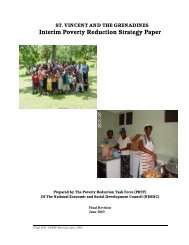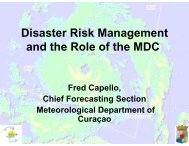The Anatomy of A Silent Crisis The Anatomy of A Silent Crisis
The Anatomy of A Silent Crisis The Anatomy of A Silent Crisis
The Anatomy of A Silent Crisis The Anatomy of A Silent Crisis
- TAGS
- anatomy
- www.bb.undp.org
Create successful ePaper yourself
Turn your PDF publications into a flip-book with our unique Google optimized e-Paper software.
62 Forum 2009: Climate Change – <strong>The</strong> <strong>Anatomy</strong> <strong>of</strong> a <strong>Silent</strong> <strong>Crisis</strong><br />
“ It is a matter <strong>of</strong> social justice. If we care about<br />
injustice and inequality, we must care about climate<br />
change. Climate change exacerbates existing<br />
inequalities including the different vulnerabilities <strong>of</strong><br />
men and women.” Barbara Stocking — Chief Executive, Oxfam GB, Oxford, England<br />
Climate change exacerbates gender inequalities. Women account for two-thirds <strong>of</strong> the world’s<br />
poor. 194 70-80 percent <strong>of</strong> agricultural workers are women. <strong>The</strong>y are also largely responsible for<br />
water collection and <strong>of</strong>ten serve as the primary caretaker in a household. 195 As a result, climate<br />
change impacts like decreased farm yields and water supply disproportionately impact women<br />
by reducing their livelihoods, impairing food provision and increasing their household workload.<br />
75 percent <strong>of</strong> deaths in climate disasters are female, 196 due to factors like an inability to swim that<br />
leads to drowning during floods; constricting dress-codes inhibiting fast movement; and behavioural<br />
restrictions forbidding women from leaving the house without male relatives. 197 Women are also more<br />
vulnerable to climate related displacement and conflict, with women representing the majority <strong>of</strong><br />
climate displaced people. 198 This vulnerability and inequality <strong>of</strong>ten relegates women to the worst paid,<br />
least regulated jobs and can place them at higher risk <strong>of</strong> sexual exploitation. 198<br />
A global justice concern: Those who suffer most from climate change have done the least to cause it<br />
<strong>The</strong> global pollutants that contribute to climate change do not adhere to national or regional<br />
boundaries. <strong>The</strong>y impact people regardless <strong>of</strong> where they were produced and by whom. <strong>The</strong><br />
world’s poorest have not benefited from the decades <strong>of</strong> economic growth that have accelerated<br />
global warming. <strong>The</strong> poor are also only responsible for a small part <strong>of</strong> the emissions that contribute<br />
to climate change — yet they suffer the majority <strong>of</strong> the human impact <strong>of</strong> climate change. <strong>The</strong>se<br />
contrasting realities <strong>of</strong> responsibility and human impact <strong>of</strong> climate change raise significant concerns<br />
<strong>of</strong> global justice.<br />
Carbon dioxide emissions are considered by far the number one cause <strong>of</strong> global warming. 65<br />
Figure 12 on next page illustrates the imbalances between carbon emissions in the North versus<br />
the South.







